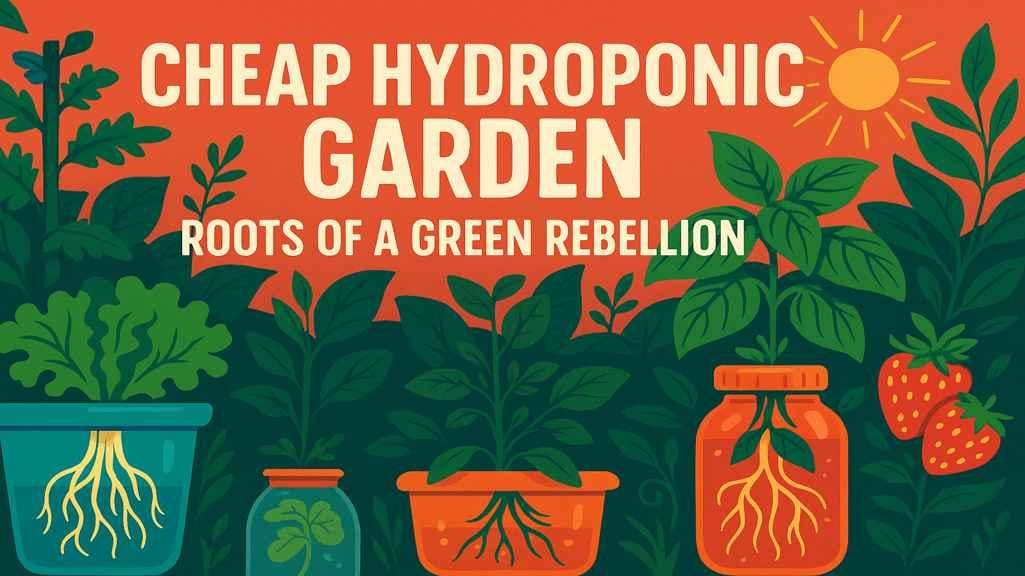Once upon a not-so-fairytale time, we were told that growing food meant sprawling fields, muddy boots, and backbreaking labor under the scorching sun. But not anymore. In the age of concrete jungles and collapsing ecosystems, the most radical act might just be growing your dinner from a plastic tub and a whisper of light. Welcome to the quiet revolution called the cheap hydroponic garden.
This isn’t just gardening. It’s a manifesto. A pushback against chemical-soaked produce, against wasteful food systems, and against the idea that we must own land to belong to the earth.
Roots That Refuse to Sink
Hydroponics is a love letter to life’s refusal to surrender. Without soil, roots stretch directly into water, drinking nutrients like morning coffee, dancing in gravity-defying stillness. And no, it doesn’t take a lab coat or a tech startup budget. Just water, light, and belief.
The Kratky method is the anthem of minimalist gardeners and rebels alike. A container, some water, a plant in a net cup—it’s so simple it feels like cheating. But that’s the point. Nature never asked for perfection. She only asks for space to grow.
Trash Transformed: A Story of Redemption
We live in a world overflowing with plastic. But what if every milk jug, every Styrofoam cooler, and every soda bottle we’ve tossed was just a garden in disguise? The cheap hydroponic garden is where waste goes to be forgiven.
It’s not just about saving money—it’s about giving objects a second life with hydroponic gardens. Upcycling isn’t a crafty weekend project; it’s an act of rebellion against a culture that tosses too much and grows too little. That cracked aquarium in your basement? A future tomato sanctuary. That old dish rack? Lettuce scaffolding.
The Vertical Uprising
No yard? No problem. This revolution climbs. In tiny apartments and tight balconies, vertical hydroponic gardens rise like green sculptures—towers of thyme, basil, and kale growing in recycled soda bottles or rain gutters.
This isn’t just spatial efficiency. It’s symbolic. In a world running out of room, we look up. We say growth has no floor, only direction. Up.
Let There Be (Cheap) Light
In hydroponics, light is love. And while the sun is free, windows are not always generous. Enter the humble LED shop light—a working-class hero in this movement. No fancy “plant lamps” needed. Just a full-spectrum bulb, a timer, and the gentle buzz of life photosynthesizing in defiance.
This is the poetry of artificial photosynthesis. It’s how we tell plants, “We’ve got you,” even when the clouds don’t.
Budget Is Not a Barrier, It’s a Beacon
The word “cheap” often gets misunderstood. But here, it means it is accessible. Ethical. Humble. The cheap hydroponic garden doesn’t aim to impress—it aims to empower. It rejects the notion that sustainability is a luxury or that green living must come in sleek white packaging with a four-digit price tag.
This garden is proof that you don’t need wealth to reclaim agency over your food. You just need willpower, water, and maybe a few yogurt cups.
DIY Dreams, Grown by Hand
There is something profoundly healing about growing food. Not in the romanticized, Instagram-filtered way. But in the quiet moments: rinsing your hands in nutrient water, watching a tiny root push itself into being, whispering encouragement to a fragile sprout.
The cheap hydroponic garden is more than a method. It’s a meditation. It asks us to slow down, to notice, and to participate in creation instead of just consumption. It’s where your spinach becomes an ally, not just a side dish.
The Greenest Anarchy
Make no mistake: this is resistance. To plant your own food is to say, “I see through the system.” It’s to question why a strawberry must travel 1,000 miles to reach your mouth. It’s to refuse plastic-wrapped basil that expires before it wilts.
Every mason jar filled with lettuce and every reused water bottle dripping nutrients is a raised fist in a green revolution. It may not shout, but it speaks volumes.
Growing Peace, One Root at a Time
In a time when environmental collapse looms and disconnection runs deep, the cheap hydroponic garden offers more than greens—it offers grounding. It is a statement that says, I will grow gently. I will consume consciously. I will live in harmony with other living things.
You don’t need acres. You don’t need money. You only need heart, a bit of light, and the courage to start.
So find a jar. Find a window. And plant your rebellion.
FAQs
Can plants really grow without soil?
Yes. Roots care more about access to nutrients than dirt. Hydroponics gives them exactly what they need—no more, no less.
Is this sustainable?
Far more than traditional gardening. Less water, no pesticides, less packaging. It’s a step toward a gentler way of living.
Do I need electricity?
Not always. Some methods, like Kratky, require none. Others need minimal power for lights or small water pumps.
What about animals and other life?
Hydroponics doesn’t displace wildlife or damage soil ecosystems. In some cases, like aquaponics, it invites other creatures into the loop respectfully.
Is this really cheap?
Yes. With reused materials and smart nutrient choices, you can grow for a fraction of store prices. And what’s more valuable than independence?
https://www.africanexponent.com/cheap-hydroponic-garden-roots-of-a-green-rebellion/


